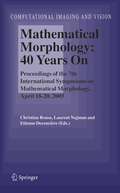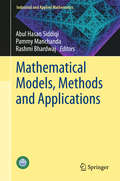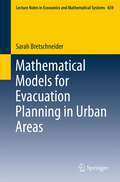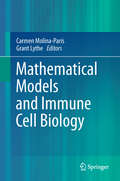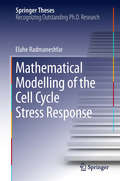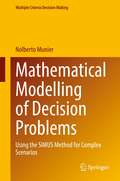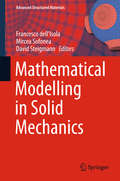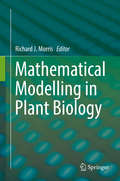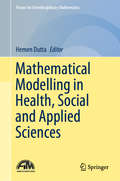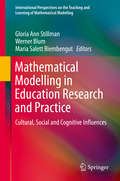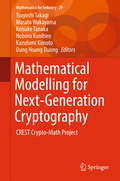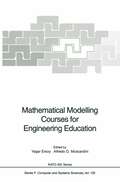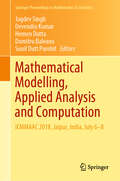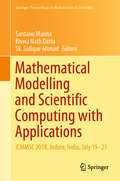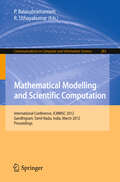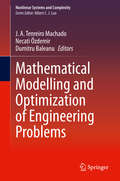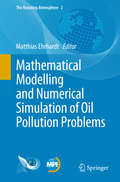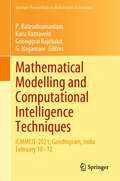- Table View
- List View
Mathematical Morphology and Its Applications to Image and Signal Processing (Computational Imaging and Vision #5)
by Petros Maragos Ronald W. Schafer Muhammad Akmal ButtMathematical morphology (MM) is a powerful methodology for the quantitative analysis of geometrical structures. It consists of a broad and coherent collection of theoretical concepts, nonlinear signal operators, and algorithms aiming at extracting, from images or other geometrical objects, information related to their shape and size. Its mathematical origins stem from set theory, lattice algebra, and integral and stochastic geometry. MM was initiated in the late 1960s by G. Matheron and J. Serra at the Fontainebleau School of Mines in France. Originally it was applied to analyzing images from geological or biological specimens. However, its rich theoretical framework, algorithmic efficiency, easy implementability on special hardware, and suitability for many shape- oriented problems have propelled its widespread diffusion and adoption by many academic and industry groups in many countries as one among the dominant image analysis methodologies. The purpose of Mathematical Morphology and its Applications to Image and Signal Processing is to provide the image analysis community with a sampling from the current developments in the theoretical (deterministic and stochastic) and computational aspects of MM and its applications to image and signal processing. The book consists of the papers presented at the ISMM'96 grouped into the following themes: Theory Connectivity Filtering Nonlinear System Related to Morphology Algorithms/Architectures Granulometries, Texture Segmentation Image Sequence Analysis Learning Document Analysis Applications
Mathematical Morphology and Its Applications to Image and Signal Processing: 10th International Symposium, ISMM 2011, Verbania-Intra, Italy, July 6-8, 2011, Proceedings (Lecture Notes in Computer Science #6671)
by Georgios Ouzounis Pierre Soille Martino PesaresiThis book contains the refereed proceedings of the 10th International Symposium on Mathematical Morphology, ISMM 2011 held in Verbania-Intra, Italy in July 2011. It is a collection of 39 revised full papers, from which 27 were selected for oral and 12 for poster presentation, from a total of 49 submissions. Moreover, the book features two invited contributions in the fields of remote sensing, image analysis and scientific visualization. The papers are organized in thematic sections on theory, lattices and order, connectivity, image analysis, processing and segmentation, adaptive morphology, algorithms, remote sensing, visualization, and applications.
Mathematical Morphology and Its Application to Signal and Image Processing: 9th International Symposium on Mathematical Morphology, ISMM 2009 Groningen, The Netherlands, August 24-27, 2009 Proceedings (Lecture Notes in Computer Science #5720)
by Michael H. F. Wilkinson Jos B. T. M. RoerdinkThe 9th ISMM conference covered a very diverse collection of papers, bound together by the central themes of mathematical morphology, namely, the tre- ment of images in terms of set and lattice theory. Notwithstanding this central theme, this ISMM showed increasing interaction with other ?elds of image and signal processing, and several hybrid methods were presented, which combine the strengths of traditional morphological methods with those of, for example, linear ?ltering.This trendis particularlystrong in the emerging?eld of adaptive morphological ?ltering, where the local shape of structuring elements is det- mined by non-morphological techniques. This builds on previous developments of PDE-based methods in morphology and amoebas. In segmentation we see similar advancements, in the development of morphological active contours. Even within morphology itself, diversi?cation is great, and many new areas of research are being opened up. In particular, morphology of graph-based and complex-based image representations are being explored. Likewise, in the we- established area of connected ?ltering we ?nd new theory and new algorithms, but also expansion into the direction of hyperconnected ?lters. New advances in morphological machine learning, multi-valued and fuzzy morphology are also presented. Notwithstanding the often highly theoretical reputation of mathematical morphology, practitioners in this ?eld have always had an eye for the practical.
Mathematical Morphology: Proceedings of the 7th International Symposium on Mathematical Morphology, April 18-20, 2005 (Computational Imaging and Vision #30)
by Christian Ronse Laurent Najman Etienne DecencièreMathematical Morphology is a speciality in Image Processing and Analysis, which considers images as geometrical objects, to be analyzed through their interactions with other geometrical objects. It relies on several branches of mathematics, such as discrete geometry, topology, lattice theory, partial differential equations, integral geometry and geometrical probability. It has produced fast and efficient algorithms for computer analysis of images, and has found applications in bio-medical imaging, materials science, geoscience, remote sensing, quality control, document processing and data analysis. This book contains the 43 papers presented at the 7th International Symposium on Mathematical Morphology, held in Paris on April 18-20, 2005. It gives a lively state of the art of current research topics in this field. It also marks a milestone, the 40 years of uninterrupted development of this ever-expanding domain.
Mathematical Models, Methods and Applications (Industrial and Applied Mathematics)
by Abul Hasan Siddiqi Pammy Manchanda Rashmi BhardwajThe present volume contains invited talks of 11th biennial conference on “Emerging Mathematical Methods, Models and Algorithms for Science and Technology”. The main message of the book is that mathematics has a great potential to analyse and understand the challenging problems of nanotechnology, biotechnology, medical science, oil industry and financial technology. The book highlights all the features and main theme discussed in the conference. All contributing authors are eminent academicians, scientists, researchers and scholars in their respective fields, hailing from around the world.
Mathematical Models for Registration and Applications to Medical Imaging (Mathematics in Industry #10)
by Otmar ScherzerThis volume gives a survey on mathematical and computational methods in image registration. During the last year sophisticated numerical models for registration and efficient numerical methods have been proposed. Many of them are contained in this volume. The book also summarizes the state-of-the-art in mathematical and computational methods in image registration. In addition, it covers some practical applications and new directions with industrial relevance in data processing.
Mathematical Models for Evacuation Planning in Urban Areas (Lecture Notes in Economics and Mathematical Systems #659)
by Sarah BretschneiderDisasters like floods, hurricanes, chemical or nuclear accidents may cause the necessity to evacuate the affected area. The evacuation of the urban area needs to be planned carefully. One issue is the reorganization of the traffic routing. Congested urban areas have usually complex street networks that are composed of many intersections with streets connecting them. The population density of a congested urban area is usually high and the street network is already used to capacity during rush hour traffic. The considered problem of this work is the reorganization of the traffic routing of an urban area for the case of an emergency mass evacuation. Especially aspects of the evacuation like safety, avoidance of delays and the total system travel time are taken into account. Combinatorial and graph theoretical aspects are adapted for the evacuation problem and highlight issues concerning especially conflicts within intersections. This work gives an extensive summary of literature of evacuation of urban areas. Mixed-integer linear programming models are developed for evacuation problems and heuristic algorithms are provided and tested.?
Mathematical Models for Eddy Currents and Magnetostatics: With Selected Applications (Scientific Computation)
by Rachid Touzani Jacques RappazThis monograph addresses fundamental aspects of mathematical modeling and numerical solution methods of electromagnetic problems involving low frequencies, i.e. magnetostatic and eddy current problems which are rarely presented in the applied mathematics literature. In the first part, the authors introduce the mathematical models in a realistic context in view of their use for industrial applications. Several geometric configurations of electric conductors leading to different mathematical models are carefully derived and analyzed, and numerical methods for the solution of the obtained problems are given. Related issues such as convergence of the approximations and error estimates are discussed. The second part of the monograph presents various coupled problems that involve eddy current or magnetostatic problems, in particular magneto-hydrodynamic problems and magnetic shaping problems concerning the melt flow of electrically conducting metals, induction heating processes, inductively coupled plasmas and ferromagnetic screening modeling. The presentation of each model comes with numerical illustration from industrial applications.
Mathematical Models for Decision Support (NATO ASI Subseries F: #48)
by Harvey J. Greenberg Freerk A. Lootsma Marcel J. Rijckaert Hans J. ZimmermannIt is quite an onerous task to edit the proceedings of a two week long institute with learned contributors from many parts of the world. All the same, the editorial team has found the process of refereeing and reviewing the contributions worthwhile and completing the volume has proven to be a satisfying task. In setting up the institute we had considered models and methods taken from a number of different disciplines. As a result the whole institute - preparing for it, attending it and editing the proceedings - proved to be an intense learning experience for us. Here I speak on behalf of the committee and the editorial team. By the time the institute took place, the papers were delivered and the delegates exchanged their views, the structure of the topics covered and their relative positioning appeared in a different light. In editing the volume I felt compelled to introduce a new structure in grouping the papers. The contents of this volume are organised in eight main sections set out below: 1 . Abstracts. 2. Review Paper. 3. Models with Multiple Criteria and Single or Multiple Decision Makers. 4. Use of Optimisation Models as Decision Support Tools. 5. Role of Information Systems in Decision Making: Database and Model Management Issues. 6. Methods of Artificial Intelligence in Decision Making: Intelligent Knowledge Based Systems. 7. Representation of Uncertainty in Mathematical Models and Knowledge Based Systems. 8. Mathematical Basis for Constructing Models and Model Validation.
Mathematical Models and Methods for Ab Initio Quantum Chemistry (Lecture Notes in Chemistry #74)
by M. Defranceschi C. Le BrisOn the occasion of the fourth International Conference on Industrial and Applied Mathematics!, we decided to organize a sequence of 4 minisymposia devoted to the mathematical aspects and the numerical aspects of Quantum Chemistry. Our goal was to bring together scientists from different communities, namely mathematicians, experts at numerical analysis and computer science, chemists, just to see whether this heterogeneous set of lecturers can produce a rather homogeneous presentation of the domain to an uninitiated audience. To the best of our knowledgde, nothing of this kind had never been tempted so far. It seemed to us that it was the good time for doing it, both . because the interest of applied mathematicians into the world of computational chemistry has exponentially increased in the past few years, and because the community of chemists feels more and more concerned with the numerical issues. Indeed, in the early years of Quantum Chemistry, the pioneers (Coulson, Mac Weeny, just to quote two of them) used to solve fundamental equations modelling toy systems which could be simply numerically handled in view of their very limited size. The true difficulty arose with the need to model larger systems while possibly taking into account their interaction with their environment. Hand calculations were no longer possible, and computing science came into the picture.
Mathematical Models and Immune Cell Biology
by Carmen Molina-París Grant LytheWhole new areas of immunological research are emerging from the analysis of experimental data, going beyond statistics and parameter estimation into what an applied mathematician would recognise as modelling of dynamical systems. Stochastic methods are increasingly important, because stochastic models are closer to the Brownian reality of the cellular and sub-cellular world.
Mathematical Modelling of the Cell Cycle Stress Response (Springer Theses)
by Elahe RadmaneshfarThe cell cycle is a sequence of biochemical events that are controlled by complex but robust molecular machinery. This enables cells to achieve accurate self-reproduction under a broad range of conditions. Environmental changes are transmitted by molecular signaling networks, which coordinate their actions with the cell cycle. This work presents the first description of two complementary computational models describing the influence of osmotic stress on the entire cell cycle of S. cerevisiae. Our models condense a vast amount of experimental evidence on the interaction of the cell cycle network components with the osmotic stress pathway. Importantly, it is only by considering the entire cell cycle that we are able to make a series of novel predictions which emerge from the coupling between the molecular components of different cell cycle phases. The model-based predictions are supported by experiments in S. cerevisiae and, moreover, have recently been observed in other eukaryotes. Furthermore our models reveal the mechanisms that emerge as a result of the interaction between the cell cycle and stress response networks.
Mathematical Modelling of Decision Problems: Using the SIMUS Method for Complex Scenarios (Multiple Criteria Decision Making)
by Nolberto MunierThis book is intended as a guide to and manual on modeling complex problems in Multi Criteria Decision Making (MCDM). It encourages practitioners to consider the practicalities of real-world scenarios when modeling, while at the same time providing tips and examples of how to incorporate these realities into the initial decision matrix. The goal is to help readers build a decision matrix that replicates reality as closely as possible. Once this matrix has been constructed, the Decision Maker (DM) can select from more than a hundred MCDM methods the one that best fits the requirements and conditions of the matrix. The book features cases taken from real-world scenarios, which deal with various fields, aspects, and characteristics, and are solved using the SIMUS (Sequential Interactive Modeling for Urban Systems) method. This book is a valuable tool for practitioners, researchers and students dealing with MCDM problems.
Mathematical Modelling in Solid Mechanics (Advanced Structured Materials #69)
by Francesco Dell'Isola Mircea Sofonea David SteigmannThis book presents new research results in multidisciplinary fields of mathematical and numerical modelling in mechanics. The chapters treat the topics: mathematical modelling in solid, fluid and contact mechanicsnonconvex variational analysis with emphasis to nonlinear solid and structural mechanicsnumerical modelling of problems with non-smooth constitutive laws, approximation of variational and hemivariational inequalities, numerical analysis of discrete schemes, numerical methods and the corresponding algorithms, applications to mechanical engineeringnumerical aspects of non-smooth mechanics, with emphasis on developing accurate and reliable computational toolsmechanics of fibre-reinforced materialsbehaviour of elasto-plastic materials accounting for the microstructural defectsdefinition of structural defects based on the differential geometry concepts or on the atomistic basisinteraction between phase transformation and dislocations at nano-scaleenergetic argumentsbifurcation and post-buckling analysis of elasto-plastic structuresengineering optimization and design, global optimization and related algorithms The book presents selected papers presented at ETAMM 2016. It includes new and original results written by internationally recognized specialists.
Mathematical Modelling in Plant Biology
by Richard J. MorrisProgress in plant biology relies on the quantification, analysis and mathematical modeling of data over different time and length scales. This book describes common mathematical and computational approaches as well as some carefully chosen case studies that demonstrate the use of these techniques to solve problems at the forefront of plant biology. Each chapter is written by an expert in field with the goal of conveying concepts whilst at the same time providing sufficient background and links to available software for readers to rapidly build their own models and run their own simulations. This book is aimed at postgraduate students and researchers working the field of plant systems biology and synthetic biology, but will also be a useful reference for anyone wanting to get into quantitative plant biology.
Mathematical Modelling in Health, Social and Applied Sciences (Forum for Interdisciplinary Mathematics)
by Hemen DuttaThis book discusses significant research findings in the field of mathematical modelling, with particular emphasis on important applied-sciences, health, and social issues. It includes topics such as model on viral immunology, stochastic models for the dynamics of influenza, model describing the transmission of dengue, model for human papillomavirus (HPV) infection, prostate cancer model, realization of economic growth by goal programming, modelling of grazing periodic solutions in discontinuous systems, modelling of predation system, fractional epidemiological model for computer viruses, and nonlinear ecological models. A unique addition in the proposed areas of research and education, this book is a valuable resource for graduate students, researchers and educators associated with the study of mathematical modelling of health, social and applied-sciences issues. Readers interested in applied mathematics should also find this book valuable.
Mathematical Modelling in Education Research and Practice: Cultural, Social and Cognitive Influences (International Perspectives on the Teaching and Learning of Mathematical Modelling)
by Gloria Ann Stillman Werner Blum Maria Salett BiembengutIn this volume cultural, social and cognitive influences on the research and teaching of mathematical modelling are explored from a variety of theoretical and practical perspectives. The authors of the current volume are all members of the International Community of Teachers of Mathematical Modelling and Applications, the peak research body in this field. A distinctive feature of this volume is the high number of authors from South American countries. These authors bring quite a different perspective to modelling than has been showcased in previous books in this series, in particular from a cultural point of view. As well as recent international research, there is a strong emphasis on pedagogical issues including those associated with technology and assessment, in the teaching and learning of modelling. Applications at various levels of education are exemplified. The contributions reflect common issues shared globally and represent emergent or on-going challenges.
Mathematical Modelling for Next-Generation Cryptography: CREST Crypto-Math Project (Mathematics for Industry #29)
by Tsuyoshi Takagi Masato Wakayama Keisuke Tanaka Noboru Kunihiro Kazufumi Kimoto Dung Hoang DuongThis book presents the mathematical background underlying security modeling in the context of next-generation cryptography. By introducing new mathematical results in order to strengthen information security, while simultaneously presenting fresh insights and developing the respective areas of mathematics, it is the first-ever book to focus on areas that have not yet been fully exploited for cryptographic applications such as representation theory and mathematical physics, among others. Recent advances in cryptanalysis, brought about in particular by quantum computation and physical attacks on cryptographic devices, such as side-channel analysis or power analysis, have revealed the growing security risks for state-of-the-art cryptographic schemes. To address these risks, high-performance, next-generation cryptosystems must be studied, which requires the further development of the mathematical background of modern cryptography. More specifically, in order to avoid the security risks posed by adversaries with advanced attack capabilities, cryptosystems must be upgraded, which in turn relies on a wide range of mathematical theories. This book is suitable for use in an advanced graduate course in mathematical cryptography, while also offering a valuable reference guide for experts.
Mathematical Modelling Courses for Engineering Education (NATO ASI Subseries F: #132)
by Yasar Ersoy Alfredo O. MoscardiniAs the role of the modern engineer is markedly different from that of even a decade ago, the theme of engineering mathematics educa tion (EME) is an important one. The need for mathematical model ling (MM) courses and consideration of the educational impact of computer-based technology environments merit special attention. This book contains the proceeding of the NATO Advanced Research Workshop held on this theme in July 1993. We have left the industrial age behind and have entered the in formation age. Computers and other emerging technologies are penetrating society in depth and gaining a strong influence in de termining how in future society will be organised, while the rapid change of information requires a more qualified work force. This work force is vital to high technology and economic competitive ness in many industrialised countries throughout the world. Within this framework, the quality of EME has become an issue. It is expected that the content of mathematics courses taught in schools of engineering today have to be re-evaluated continuously with regard to computer-based technology and the needs of mod ern information society. The main aim of the workshop was to pro vide a forum for discussion between mathematicians, engineering scientists, mathematics educationalists, and courseware develop ers in the higher education sector and to focus on the issues and problems of the design of more relevant and appropriate MM courses for engineering education.
Mathematical Modelling, Applied Analysis and Computation: ICMMAAC 2018, Jaipur, India, July 6-8 (Springer Proceedings in Mathematics & Statistics #272)
by Jagdev Singh Devendra Kumar Hemen Dutta Dumitru Baleanu Sunil Dutt PurohitThis book contains original research papers presented at the International Conference on Mathematical Modelling, Applied Analysis and Computation, held at JECRC University, Jaipur, India, on 6-8 July, 2018. Organized into 20 chapters, the book focuses on theoretical and applied aspects of various types of mathematical modelling such as equations of various types, fuzzy mathematical models, automata, Petri nets and bond graphs for systems of dynamic nature and the usage of numerical techniques in handling modern problems of science, engineering and finance. It covers the applications of mathematical modelling in physics, chemistry, biology, mechanical engineering, civil engineering, computer science, social science and finance. A wide variety of dynamical systems like deterministic, stochastic, continuous, discrete or hybrid, with respect to time, are discussed in the book. It provides the mathematical modelling of various problems arising in science and engineering, and also new efficient numerical approaches for solving linear and nonlinear problems and rigorous mathematical theories, which can be used to analyze a different kind of mathematical models. The conference was aimed at fostering cooperation among students and researchers in areas of applied analysis, engineering and computation with the deliberations to inculcate new research ideas in their relevant fields. This volume will provide a comprehensive introduction to recent theories and applications of mathematical modelling and numerical simulation, which will be a valuable resource for graduate students and researchers of mathematical modelling and industrial mathematics.
Mathematical Modelling and Scientific Computing with Applications: ICMMSC 2018, Indore, India, July 19–21 (Springer Proceedings in Mathematics & Statistics #308)
by Santanu Manna Biswa Nath Datta Sk. Safique AhmadThis book contains original research papers presented at the International Conference on Mathematical Modelling and Scientific Computing, held at the Indian Institute of Technology Indore, India, on 19–21 July 2018. Organized into 30 chapters, the book presents the recent progress and the most advanced innovations, trends, and real-world challenges encountered and solutions embraced in the applications of mathematics and scientific computing. The book will be of interests to a wide variety of researchers, students and the practicing engineers working in diverse areas of science and engineering, ranging from applied and computational mathematics, vibration problem, computer science, and numerical optimization to physics, chemistry, biology, electrical, civil, mechanical, chemical, seismology, aerospace, and medical sciences. The aim of the conference is to bring together leading academicians, scientists, researchers, engineers, and industry partners from all over the globe to exchange and share their experiences and research results on various aspects of applied mathematics and scientific computation, like, differential equation, modeling, simulation, dynamical systems, numerical analysis, matrix theory, inverse problems, and solid and fluid mechanics, computational engineering.
Mathematical Modelling and Scientific Computation: International Conference, ICMMSC 2012, Gandhigram, Tamil Nadu, India, March 16-18, 2012 (Communications in Computer and Information Science #283)
by P. Balasubramaniam R. UthayakumarThis book constitutes the refereed proceedings of the International Conference on Mathematical Modelling and Scientific Intelligence, ICMMSC 2012, Gandhigram, Tamil Nadu, India, in March 2012. The 62 revised full papers presented were carefully reviewed and selected from 332 submissions. The papers are organized in two topical sections on mathematical modelling and on scientific computation.
Mathematical Modelling and Optimization of Engineering Problems (Nonlinear Systems and Complexity #30)
by J. A. Tenreiro Machado Necati Özdemir Dumitru BaleanuThis book presents recent developments in modelling and optimization of engineering systems and the use of advanced mathematical methods for solving complex real-world problems. It provides recent theoretical developments and new techniques based on control, optimization theory, mathematical modeling and fractional calculus that can be used to model and understand complex behavior in natural phenomena including latest technologies such as additive manufacturing. Specific topics covered in detail include combinatorial optimization, flow and heat transfer, mathematical modelling, energy storage and management policy, artificial intelligence, optimal control, modelling and optimization of manufacturing systems.
Mathematical Modelling and Numerical Simulation of Oil Pollution Problems (The Reacting Atmosphere #2)
by Matthias EhrhardtWritten by outstanding experts in the fields of marine engineering, atmospheric physics and chemistry, fluid dynamics and applied mathematics, the contributions in this book cover a wide range of subjects, from pure mathematics to real-world applications in the oil spill engineering business. Offering a truly interdisciplinary approach, the authors present both mathematical models and state-of-the-art numerical methods for adequately solving the partial differential equations involved, as well as highly practical experiments involving actual cases of ocean oil pollution. It is indispensable that different disciplines of mathematics, like analysis and numerics, together with physics, biology, fluid dynamics, environmental engineering and marine science, join forces to solve today’s oil pollution problems.The book will be of great interest to researchers and graduate students in the environmental sciences, mathematics and physics, showing the broad range of techniques needed in order to solve these pollution problems; and to practitioners working in the oil spill pollution industry, offering them a professional reference resource.
Mathematical Modelling and Computational Intelligence Techniques: ICMMCIT-2021, Gandhigram, India February 10–12 (Springer Proceedings in Mathematics & Statistics #376)
by Grienggrai Rajchakit P. Balasubramaniam Kuru Ratnavelu G. NagamaniThis book collects papers presented at the International Conference on Mathematical Modelling and Computational Intelligence Techniques (ICMMCIT) 2021, held at the Department of Mathematics, The Gandhigram Rural Institute (Deemed to be University), Gandhigram, Tamil Nadu, India, from 10–12 February 2021. Significant contributions from renowned researchers from fields of applied analysis, mathematical modelling and computing techniques have been received for this conference. Chapters emphasize on the research of computational nature focusing on new algorithms, their analysis and numerical results, as well as applications in physical, biological, social, and behavioural sciences. The accepted papers are organized in topical sections as mathematical modelling, image processing, control theory, graphs and networks, and inventory control.



